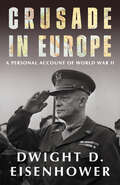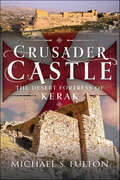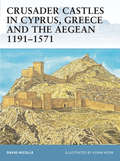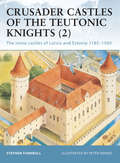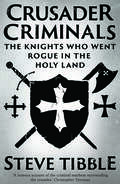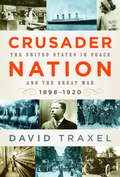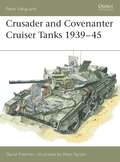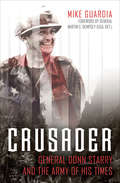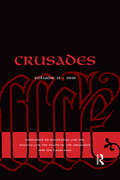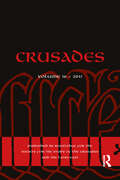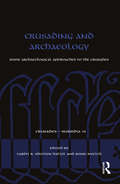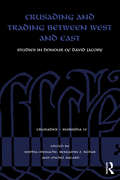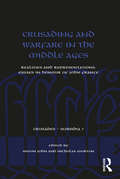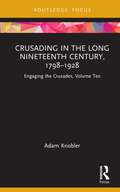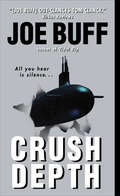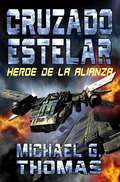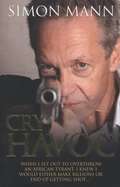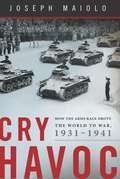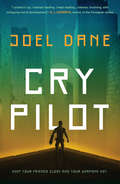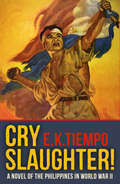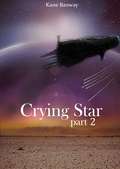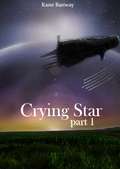- Table View
- List View
Crusade in Europe
by Dwight D. EisenhowerFive-star General Dwight D. Eisenhower was arguably the single most important military figure of World War II. For many historians, his memoirs of this eventful period of U.S. history have become the single most important record of the war. Crusade in Europe tells the complete story of the war as Eisenhower planned and lived it. Through his eyes, the enormous scope and drama of the war—strategy, battles, moments of fateful decision—become fully illuminated in all their fateful glory. Yet this is also a warm and richly human account. Ike recalls the long months of waiting, planning, and working toward victory in Europe. His personal record of the tense first hours after he had issued the order to attack—and there was no turning back—leaves no doubt of Eisenhower's travail and reveals this great man in ways that no biographer has ever surpassed.
Crusade: Chronicles of an Unjust War
by James CarrollAnalyzes the war against Iraq within our history of war-making.
Crusader Castle: The Desert Fortress of Kerak
by Michael S. FultonThis is the ultimate history and guide to Kerak, one of the greatest crusader castles, tracing the architectural history of the castle over the course of 800 years. The formidable strongholds built by the crusaders are among the most iconic castles of the Middle Ages. These mighty structures offer fascinating insights into the lives of those who built and occupied them, and the role they played in the region’s deep history of conflict. The castle of Kerak, in modern Jordan, is one of the largest, most imposing and best preserved of them all, and Michael Fulton’s detailed, authoritative and highly illustrated account is the ideal guide to it. His close analysis of the fabric of this monumental building, and his description of the centuries of conflict associated with it, make absorbing reading. He takes the reader through the early military history of the castle – from the time it was constructed in the 1140s by Pagan the Butler, through the provocative actions of Reynald of Châtillon and Saladin’s capture of the castle in 1188. He also recounts its later history under Muslim rule, when the castle served as a treasury for the Ayyubid and Mamluk sultans of Egypt. Falling into decline under the Ottomans, Kerak has since regained its importance as a tourist attraction. A part-by-part examination of the castle and surviving elements of the adjoining medieval town allows readers to appreciate the different stages in the development of this incredible structure and to visualize how it evolved and functioned at different points in time. The detailed architectural guide will be an essential reference for readers who have the opportunity to visit the castle and for those who are keen to gain the best possible understanding of it without going to the site.
Crusader Castles in Cyprus, Greece and the Aegean 1191-1571
by David Nicolle Adam HookCrusader castles and other fortifications in Cyprus, the south-western coast of Turkey, and Greece are among the best examples of late medieval military architecture to be seen in Europe. These important fortifications, erected by the Hospitallers during the 15th century to face the growing Ottoman Turkish threat, vary considerably from those in the Middle East. Despite there being many visible remains of fortifications in Cyprus, Greece, and the Aegean, few studies exist of these areas compared to the fortifications of the Holy Land.Providing numerous architectural plans, maps, and color illustrations, this book seeks to redress this imbalance and complement the previous bestselling treatments of Crusader fortifications in the Fortress series.
Crusader Castles of the Teutonic Knights
by Peter Dennis Stephen TurnbullThe original forced conversion of pagan Livonia, what is now the Baltic states of Latvia and Estonia, was carried out by a military order known as the Brethren of the Sword. In 1236 this order was incorporated into the Teutonic Knights following a catastrophic military defeat. The knights had always consolidated their conquests through networks of castles and fortified places, and the Livonian Chapter of the Teutonic Order built castles of stone. This title covers the developmental and operational history of these fortresses over the length of the Middle Ages. It details how the Baltic fortifications of the Teutonic Knights evolved to reflect the changing nature of siege warfare and the increasing dominance of gunpowder in warfare.From the Trade Paperback edition.
Crusader Criminals: The Knights Who Went Rogue in the Holy Land
by Steve TibbleA vivid new history of the criminal underworld in the medieval Holy Land The religious wars of the crusades are renowned for their military engagements. But the period was witness to brutality beyond the battlefield. More so than any other medieval war zone, the Holy Land was rife with unprecedented levels of criminality and violence. In the first history of its kind, Steve Tibble explores the criminal underbelly of the crusades. From gangsters and bandits to muggers and pirates, Tibble presents extraordinary evidence of an illicit underworld. He shows how the real problem in the region stemmed not from religion but from young men. Dislocated, disinhibited, and present in disturbingly large numbers, they were the propellant that stoked two centuries of unceasing warfare and shocking levels of criminality. Crusader Criminals charts the downward spiral of desensitisation that grew out of the horrors of incessant warfare—and in doing so uncovers some of the most surprising stories of the time.
Crusader Nation: The United States in Peace and the Great War, 1898-1920
by David TraxelIn this absorbing history of the first two decades of the twentieth century, David Traxel paints a vivid picture of a transformative period in the United States, when many remarkable individuals fought to decide which path the country would follow. Victorian restraint was being cast aside by men and women testing social conventions and sexual mores, dancing to dangerous "jazz" music, and expressing themselves through revolutionary forms of art. Traxel traces how these modern ideas were also related to a powerful progressive reform movement that hoped to end the social evils that had accompanied unrestrained industrialization, and he examines the impact of huge waves of European immigration on both the American economy and its social fabric. The struggles to end child labor, win votes for women, rid cities of corrupt political machines, improve public health and education, and prohibit alcohol brought forth a passionate response from millions of Americans who desired both a more efficient and a more compassionate society. Greenwich Village bohemians including Jack Reed, Eugene O'Neill, and Louise Bryant; politicians such as Theodore Roosevelt and Woodrow Wilson; social reformers Margaret Sanger and "Mother" Jones; journalists William Allen White and Lincoln Steffens; and industrialist Henry Ford come alive in these pages. They were Democrats and Republicans, progressives and Socialists, as well as radicals such as the Industrial Workers of the World and anarchists such as Emma Goldman. Combining lively anecdote with historical scholarship, Traxel shows how American crusading continued through World War I, though now focused on "making the world safe for democracy." But by the time the doughboys returned the public was tired of what had come to seem empty rhetoric and unattainable goals. By 1920 the Progressive Era was over, though its laws and effects have lived on. This portrait of early twentieth-century America reveals important qualities of our national character that endure to this day.
Crusader and Covenanter Cruiser Tanks 1939-45
by Peter Sarson David FletcherThe Covenanter (which never saw active service) and Crusader Cruiser tanks were developed between 1939 and 1940. The Crusader first saw action in the North African desert in June 1941: its speed and sleek design made it a hard target to hit, and the tank was well-respected by the Afrikakorps for its velocity in combat. But its hurried development prior to World War II also made it prone to mechanical failure. This book examines the Covenanter and the many variants of the Crusader tank, detailing the designs, developments and disappointments of these infamous World War II tanks.
Crusader: General Donn Starry and the Army of His Times
by Mike GuardiaThe biography of US Army general Donn Starry, creator of the AirLand Battle doctrine that led to victory in Operation Desert Storm. Donn Starry, one of the most influential commanders of the Vietnam War, went on to become one of the &“intellectual giants&” who reshaped the US Army and, throughout his career, worked to improve training, leadership, and conditions for the men who served under him. Starry was a leading advocate for tank warfare in Vietnam. His recommendations helped shape the American armor position in Southeast Asia and paved the way for his success as commander of the 11th Armored Cavalry during the invasion of Cambodia. As commander of Fort Knox and the US Army Armor School in the 1970s, Starry brought new advances to armor tactics, training, and strategy. Most notably, he created the new &“AirLand Battle&” doctrine, which paved the way for a decisive US victory in the Gulf War. Like most Vietnam-era commanders, Starry&’s legacy has been overshadowed by the controversy surrounding the war itself—but few have had as much of an impact on modern maneuver warfare. In this new biography of Gen. Donn Starry, armor officer Mike Guardia examines the life and work of this pioneering officer using extracts from interviews with veterans and family, as well as from Starry&’s personal papers.
Crusades: Volume 15 (Crusades)
by Jonathan Riley-Smith Jonathan Phillips Benjamin Z. Kedar Nikolaos G. ChrissisCrusades covers seven hundred years from the First Crusade (1095-1102) to the fall of Malta (1798) and draws together scholars working on theatres of war, their home fronts and settlements from the Baltic to Africa and from Spain to the Near East and on theology, law, literature, art, numismatics and economic, social, political and military history. Routledge publishes this journal for The Society for the Study of the Crusades and the Latin East. Particular attention is given to the publication of historical sources in all relevant languages - narrative, homiletic and documentary - in trustworthy editions, but studies and interpretative essays are welcomed too. Crusades also incorporates the Society's Bulletin.
Crusades: Volume 16 (Crusades)
by Jonathan Phillips Benjamin Z. Kedar Nikolaos G. ChrissisCrusades covers seven hundred years from the First Crusade (1095-1102) to the fall of Malta (1798) and draws together scholars working on theatres of war, their home fronts and settlements from the Baltic to Africa and from Spain to the Near East and on theology, law, literature, art, numismatics and economic, social, political and military history. Routledge publishes this journal for The Society for the Study of the Crusades and the Latin East. Particular attention is given to the publication of historical sources in all relevant languages - narrative, homiletic and documentary - in trustworthy editions, but studies and interpretative essays are welcomed too. Crusades also incorporates the Society's Bulletin.
Crusades: Volume 21 (Crusades)
by Jonathan Phillips Benjamin Z. Kedar Nikolaos G. Chrissis Iris ShagrirCrusades covers the seven hundred years from the First Crusade (1095-1102) to the fall of Malta (1798) and draws together scholars working on theatres of war, their home fronts and settlements from the Baltic to Africa and from Spain to the Near East and on theology, law, literature, art, numismatics and economic, social, political and military history. Routledge publishes this journal for The Society for the Study of the Crusades and the Latin East. Particular attention is given to the publication of historical sources - narrative, homiletic and documentary - but studies and interpretative essays are welcomed too. Crusades also incorporates the Society's Bulletin. The editors are Professor Jonathan Phillips, Royal Holloway, University of London, UK; Iris Shagrir, The Open University of Israel; Professor Benjamin Z. Kedar, Hebrew University of Jerusalem, Israel; and Nikolaos G. Chrissis, Democritus University of Thrace, Greece.
Crusading Against Christians in the Middle Ages
by Nikolaos G. Chrissis Mike Carr Gianluca RaccagniThis is the first book-length study into crusading against Christians, examining this complex phenomenon from the twelfth to fifteenth centuries and across numerous regions, from France to Russia and from southern Italy to the Baltic. Whilst the crusades are an immensely popular topic, those launched against Christian rulers and communities have been comparatively overlooked in the past, with existing studies typically focusing on a particular area, period, or campaign. This volume brings together the expertise of thirteen scholars on a variety of primary and secondary sources not often accessible to Anglophone readership, as well as their knowledge of national discourses which have often shaped historiography. It aims to serve as the first port of call for anyone who wishes to approach crusades against Christians within and without the specialism of crusader studies, and to provide the basis for a thorough comparative analysis of this phenomenon, covering its variety as comprehensively as possible.
Crusading and Archaeology: Some Archaeological Approaches to the Crusades (Crusades - Subsidia)
by Shotten-Hallel, Vardit R.Between the eleventh and fifteenth centuries, the social and cultural worlds of medieval Europe and the Eastern Mediterranean were transformed by the religious impetus of the crusades. Today we bear witness to these transformations in the material and environmental record revealed by new archaeological excavations and reappraisals of museum collections. This volume highlights new archaeological knowledge being developed by scholars working in the fields of history, archaeology, numismatics, and architecture to demonstrate its potential to change and augment our understanding of the crusades. The 16 chapters in this volume deploy a contemporary scientific approach to archaeology of the crusades to give an up-to-date account into the diverse range of research in this area. They explore five key themes: the implications of scientific methods, new excavations and surveys, architectural analyses, sigillography, and the application of social interpretations. Together these chapters provide a new way of approaching the study of the crusades, and demonstrate the value of taking a holistic view that utilises the full diverse range of evidence available to us.
Crusading and Trading between West and East: Studies in Honour of David Jacoby (Crusades - Subsidia)
by Benjamin Z. Kedar Sophia Menache Michel BalardFor almost sixty years Professor David Jacoby devoted his research to the economic, social and cultural history of the Eastern Mediterranean and this new collection reflects his impact on the study of the interactions between the Italian city-states, Byzantium, the Latin East and the realm of Islam. Contributors to this volume are prominent scholars from across Medieval Studies and leading historians of the younger generation.
Crusading and Warfare in the Middle Ages: Realities and Representations. Essays in Honour of John France (Crusades - Subsidia #7)
by Nicholas Morton Simon JohnThis volume has been created by scholars from a range of disciplines who wish to show their appreciation for Professor John France and to celebrate his career and achievements. For many decades, Professor France’s work has been instrumental in many of the advances made in the fields of crusader studies and medieval warfare. He has published widely on these topics including major publications such as: Victory in the East: A Military History of the First Crusade (1994) and Western Warfare in the Age of the Crusades (1999). This present volume mirrors his interests, offering studies upon both areas. The fifteen essays cover a wide variety of topics, spanning chronologically from the Carolingian period through to the early fourteenth century. Some offer new insights upon long-contested issues, such as the question of whether a new form of cavalry was created by Charles Martel and his successors or the implications of the Mongol defeat at Ayn Jalut. Others use innovative methodologies to unlock the potential of various types of source material including: manuscript illuminations depicting warfare, Templar graffiti, German crusading songs, and crusading charters. Several of the articles open up new areas of debate connected to the history of crusading. Malcolm Barber discusses why Christendom did not react decisively to the fall of Acre in 1291. Bernard Hamilton explores how the rising Frankish presence in the Eastern Mediterranean during the central medieval period reshaped Christendom’s knowledge and understanding of the North African cultures they encountered. In this way, this work seeks both to advance debate in core areas whilst opening new vistas for future research.
Crusading in the Long Nineteenth Century, 1798–1928: Engaging the Crusades, Volume Ten (Engaging the Crusades)
by Adam KnoblerEngaging the Crusades is a series of concise volumes (up to 50,000 words) that offer initial windows into the ways in which the crusades have been used in the last two centuries, demonstrating that the memory of the crusades is an important and emerging subject. Together these studies suggest that the memory of the crusades, in the modern period, is a productive, exciting, and much-needed area of investigation.Crusading in the Long Nineteenth Century offers a trans-cultural examination of “crusade medievalism”, that is, the use of the symbolism and rhetoric of the crusades in the popular and political discourse of the long nineteenth century. Using a variety of sources, from missionary accounts to children’s literature, this book includes an examination of “crusade medievalism” through the politics of a European-wide audience, from states which could claim some relationship to medieval crusading, to those regions where crusading was not part of a national historical heritage. It also examines how the Islamicate world looked upon the crusades in the nineteenth and early twentieth centuries.By looking at the phenomenon of “crusade medievalism” from a multi-national perspective, this volume is of interest to medievalists, modernists and those interested in the crusades in general.
Crush Depth (The Jeffrey Fuller Novels #3)
by Joe BuffWorld War III rages on . . . “The duel between submarines and captains should keep readers flipping pages, especially if they love undersea action.” —BooklistThe Axis and Allied powers are recovering from a violent encounter between a German nuclear-powered fast-attack submarine and the USS Challenger, commanded by Captain Jeffrey Fuller. But the war has only begun . . .Reactionary enemy regimes have brutally taken command in South Africa and Germany. U.S. and European shipping lanes are suddenly under attack. World War is at hand—and for the ruthless Berlin–Boer Axis, the devastating weapons of choice will be tactical nukes used at sea.The Voortrekker, a deep-diving state-of-the-art German submarine, is on the prowl, carrying more onboard firepower than many of the world’s nations possess—and the crippled sub USS Challenger is the only weapon in America’s arsenal that can match up with the silent killer. But the nation’s last hope is in dry dock—and Captain Jeffrey Fuller, Challenger’s brilliant, driven skipper, must get his damaged boat back in action weeks before it is battle-ready. Fuller has faced Voortrekker in the past and, unlike so many others, he survived. This time, however, the fight will take place in waters far too deep for a normal sub to withstand. And this time the prize will be America.Praise for the Jeffrey Fuller series“The crème de la crème of submarine thrillers.” —Stephen Coonts, New York Times–bestselling author “If you want a hair-raising trip to the bottom of the ocean, Joe Buff’s the guy to take you there.” —Patrick Robinson, New York Times–bestselling author “[Joe Buff] out-Clancys Tom Clancy.” —Kirkus Reviews
Cruzado Estelar: Heroe de la Alianza
by Michael G. Thomas Miguelangel OviedoNate tiene talento para el combate espacial después de cientos de victorias en la simulación de videojuegos Cruzado Estelar. Sus habilidades son únicas, lo suficiente como para ganar un raro privilegio. La oportunidad de unirse a otros cinco cadetes de la Alianza y escapar de la tediosa rutina del aula. Entrarán en una competencia feroz a años luz de distancia en el antiguo Imperio Byotai. Sin embargo, días después de su llegada, una facción rebelde comienza un sangriento motín que se extiende como un reguero de pólvora. El tiempo para la competencia ha terminado; el tiempo de la guerra ha comenzado. Un puñado de naves capitales intentan evitar la masacre, pero solo Implacable escapa. Nate y sus amigos están a bordo, parte de los pocos que logran salir con vida. Implacable es una nave de asalto fuertemente blindada, una reliquia de otra época, pero la mayoría de los miembros de su tripulación están muertos o desaparecidos. Nate y sus compañeros cadetes deben enfrentar lo impensable. Bajo la guía del teniente Higgins, el último piloto de caza de la nave, los seis cadetes tienen solo días para practicar la operación de los cazas de la nave. No hay otros Solo ellos pueden defender la nave o enfrentar la muerte a manos del enemigo.
Cry Havoc
by Simon Mann<p>For the first time since he was released from five years' incarceration in some of Africa's toughest prisons, making worldwide headlines, Simon Mann breaks his silence to tell everything. <p>Simon Mann's remarkable firsthand account of his life reads like a thriller, taking readers into the world of mercenaries and spooks, of murky international politics, big oil and big bucks, action, danger, love, despair, and betrayal. On March 7, 2004, former SAS soldier and mercenary Simon Mann prepared to take off from Harare International Airport. His destination was Equatorial Guinea; his was intention to remove one of the most brutal dictators in Africa in a privately organized coup d'etat. The plot had the tacit approval of Western intelligence agencies and Mann had planned, overseen, and won two wars in Angola and Sierra Leone. So why did it go so wrong? Here he reveals the full involvement of Mark Thatcher in the coup d'etat, the endorsement of a former prime minister, and the financial involvement of two internationally famous members of the House of Lords. He also discusses how the British government approached him in the months preceding the Iraq War, to suggest ways in which a justified invasion of Iraq could be engineered. He also discusses the pain of telling his wife Amanda, who gave birth to their fourth child while he was incarcerated, that he believed he would never be freed.</p>
Cry Havoc: How the Arms Race Drove the World to War, 1931-1941
by Joe MaioloDid the arms race of the 1930s cause the Second World War? In Cry Havoc, historian Joseph Maiolo shows, in rich and fascinating detail, how the deadly game of the arms race was played out in the decade prior to the outbreak of the Second World War. In this exhaustively researched account, he explores how nations reacted to the moves of their rivals, revealing the thinking of those making the key decisions--Hitler, Mussolini, Chamberlain, Stalin, Roosevelt--and the dilemmas of democratic leaders who seemed to be faced with a choice between defending their nations and preserving their democratic way of life. An unparalleled account of an era of extreme political tension, Cry Havoc shows how the interwar arms race shaped the outcome of World War II before the shooting even began.
Cry Pilot (Cry Pilot #1)
by Joel DaneA devastated Earth. Rogue bio-weapons. And a recruit with secrets. In this explosive new military science fiction novel, a tight-knit infantry squad is thrown into battle against a mysterious enemy that appears without warning and strikes without mercy.There's only one way for a man with Maseo Kaytu's secrets to join the military: by volunteering for a suicide mission as a 'cry pilot'. He cheats the system to survive, but you can't fake basic training. Assigned to a squad of misfits, Kaytu learns how to fight, how to obey, and how to trust. Yet the more he bonds with his fellow recruits, the more he risks exposure of his criminal past. Keeping his secret is about to become the least of his problems. Kaytu discovers that his platoon is being deployed against a new kind of rogue bio-weapon. One that has torn apart every military force it's ever faced . . . .
Cry Slaughter!
by Edilberto K. TiempoCry Slaughter!, first published in 1957 is a fictionalized account of guerrilla life in the central Philippines during the Second World War. Filipino author E. K. Tiempo (1913-1996), himself a member of the Filipino resistance to the Japanese occupation, paints a vivid picture of life under the Japanese, and the difficulties faced in deciding to surrender to the Japanese or take to the mountains and form a guerrilla force. As Tiempo states in the introduction to the book, “Cry Slaughter! was based on actual situations, including the central situation of the shooting of the four envoys by the minister in the story. Many incidents in the novel were taken from They Called Us Outlaws, a non-fiction work which I wrote for the Seventh Military District of the Philippine resistance forces, as part of my work as officer in charge of the historical section. Parts of They Called Us Outlaws, (the Japanese labeled the guerrillas outlaws in those days) were used in the trial of Japanese war criminals in Manila after the war. The original manuscript of Cry Slaughter! was taken out of the Philippines in a submarine in 1943 under cover of a Philippine blackout; perhaps it was the only manuscript to successfully leave the Philippines” during the War.
Crying Star - Part 2
by Kane Banway Noele Bouazouni“Even light-years apart, we would still and forever feel the need to kill each other for one reason or another. And don’t think for a single second that humanity will be short of reasons in the future: at worst, it recycles.” The Olympus is under enemy fire. Perseus, for the first time, faces death and drastic choices for his survival. The world, his world shatters a little more every minute, and with each of his decisions. Second Part of “Crying Star”, where it is high time to put to the test Perseus’ ideals, and to see where moral values pushed to the extreme can lead.
Crying Star, Part 1
by Kane Banway Noele Bouazouni“Enlist for the coalition! Take revenge for your loved ones who have fallen battling the vile soldiers of Europa! Defend your colony, don’t give up on them, they’re counting on you!” Perseus is a young man lucky enough to have lived on a peaceful planet, where the third war of the colonies is nothing more than a vague rumor. His dream is not to destroy an enemy he sees at the most as a distant agitated neighbor, but to pilot. Approach the stars and finally feel free. But fulfilling his dream will tear apart his comfortable cocoon of principles, and make him face up to the reality of his world.
